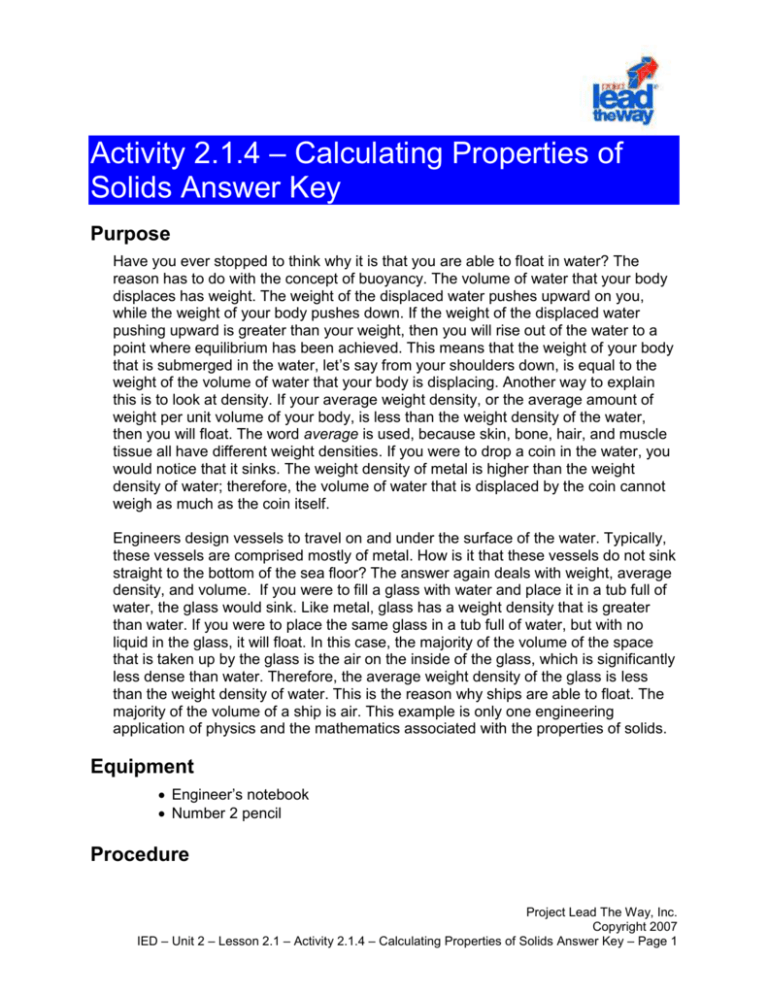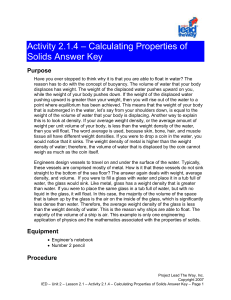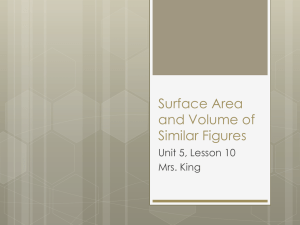Activity 2.1.4: Calculating Properties of Solids Answer Key
advertisement

Activity 2.1.4 – Calculating Properties of Solids Answer Key Purpose Have you ever stopped to think why it is that you are able to float in water? The reason has to do with the concept of buoyancy. The volume of water that your body displaces has weight. The weight of the displaced water pushes upward on you, while the weight of your body pushes down. If the weight of the displaced water pushing upward is greater than your weight, then you will rise out of the water to a point where equilibrium has been achieved. This means that the weight of your body that is submerged in the water, let’s say from your shoulders down, is equal to the weight of the volume of water that your body is displacing. Another way to explain this is to look at density. If your average weight density, or the average amount of weight per unit volume of your body, is less than the weight density of the water, then you will float. The word average is used, because skin, bone, hair, and muscle tissue all have different weight densities. If you were to drop a coin in the water, you would notice that it sinks. The weight density of metal is higher than the weight density of water; therefore, the volume of water that is displaced by the coin cannot weigh as much as the coin itself. Engineers design vessels to travel on and under the surface of the water. Typically, these vessels are comprised mostly of metal. How is it that these vessels do not sink straight to the bottom of the sea floor? The answer again deals with weight, average density, and volume. If you were to fill a glass with water and place it in a tub full of water, the glass would sink. Like metal, glass has a weight density that is greater than water. If you were to place the same glass in a tub full of water, but with no liquid in the glass, it will float. In this case, the majority of the volume of the space that is taken up by the glass is the air on the inside of the glass, which is significantly less dense than water. Therefore, the average weight density of the glass is less than the weight density of water. This is the reason why ships are able to float. The majority of the volume of a ship is air. This example is only one engineering application of physics and the mathematics associated with the properties of solids. Equipment Engineer’s notebook Number 2 pencil Procedure Project Lead The Way, Inc. Copyright 2007 IED – Unit 2 – Lesson 2.1 – Activity 2.1.4 – Calculating Properties of Solids Answer Key – Page 1 In this activity, you will learn how to hand calculate the volume, weight, and surface area of common solids. You will then apply your knowledge by calculating these properties for each of your puzzle piece solutions. 1. A cast iron cylinder serves as a counterbalance that is used in a window manufacture’s double-hung window design. The cylinder has a height of 5.25 inches and a diameter of 1.75 inches. The weight density of cast iron is .259 lbs/in3. Use this information to answer the following questions. What is the volume of the cylinder? Precision = 0.00 V = r2h V = 3.14 x (.875 in)2 x 5.25 in V = 3.14 x .766 in2 x 5.25 in V = 12.63 in3 What is the surface area of the cylinder? Precision = 0.00 SA = (2r)h + 2(r2) SA = (2 x 3.14 x .875 in) x 5.25 in + 2(3.14 x (.875 in)2) SA = 28.85 in2 + 4.82 in2 SA = 33.67 in2 What is the weight of the cylinder? Precision = 0.00 W = VDW W = 12.63 in3 x .259 lbs/in3 W = 3.27 lbs If one quart of cleaning solution will clean 7,200 square inches of surface, how many quarts will be required to clean 1,500 cylinders? Round your answer to the nearest quart. total SA = # of cylinders x SA of a cylinder total SA = 1,500 cylinders x 33.65 in2 total SA = 50,475 in2 # quarts of cleaning solution needed = total SA SA cleaned per quart # quarts of cleaning solution needed = 50,475 in2 7200 in2 per quart # quarts of cleaning solution needed = 7 quarts Project Lead The Way, Inc. Copyright 2007 IED – Unit 2 – Lesson 2.1 – Activity 2.1.4 – Calculating Properties of Solids Answer Key – Page 2 What will the total cost be to ship 200 of the cylinders if the shipping rate is $4.25 per pound? total W of all cylinders = # of cylinders to be shipped x W of one cylinder total W of all cylinders = 200 x 3.27 lbs total W of all cylinders = 654 lbs total shipping cost = total W of all cylinders x cost per pound total shipping cost = 654 lbs x $4.25 per pound total shipping cost = $2,779.50 2. A wood board is one of a dozen different parts in a homemade robot kit. The width, depth, and height dimensions of the board are 3.5 x 17 x 1.5 inches, respectively. The board is made from southern yellow pine, which has an air dry weight density of .021 lbs/in3. What is the volume of the wood board? Precision = 0.00 V = wdh V = 3.5 in x 17 in x 1.5 in V = 89.25 in3 What is the surface area of the wood board? Precision = 0.00 SA = 2(wd + wh + dh) SA = 2((3.5 in x 17 in) + (3.5 in x 1.5 in) + (17 in x 1.5 in)) SA = 2(59.5 in2 + 5.25 in2 + 25.5 in2) SA = 180.5 in2 What is the weight of the wood board? Precision = 0.00 W = VDW W = 89.25 in3 x .021 lbs/in3 W = 1.87 lbs If one gallon of paint will cover 57,600 square inches, how many gallons would be needed to give two coats of paint to 25,000 boards? Round your answer to the nearest gallon. total SA = # of boards x SA of a board total SA = 25,000 boards x 180.5 in2 total SA = 4,512,500 in2 # gallons of paint needed for 2 coats = 2 x total SA SA covered per gallon Project Lead The Way, Inc. Copyright 2007 IED – Unit 2 – Lesson 2.1 – Activity 2.1.4 – Calculating Properties of Solids Answer Key – Page 3 # gallons of paint needed for 2 coats = 2(4,512,500 in2 57,600 in2 per gallon) # gallons of paint needed for 2 coats = 157 gallons What will the total cost be to ship the 25,000 boards to a facility for assembling into the finish kit form if the shipping rate is $4.25 per pound? total W of all boards = # of boards to be shipped x W of one board total W of all boards = 25,000 x 1.87 lbs total W of all boards = 46,750 lbs total shipping cost = total W of all boards x cost per pound total shipping cost = 46,750 lbs x $4.25 per pound total shipping cost = $198,687.50 Conclusion 1. What is the difference between area and volume? Area is the measure of a two-dimensional surface. Volume is the measure of a three-dimensional space. 2. What is weight density? Weight density is how much an object or substance weighs per unit volume. 3. How does an object’s mass different from its weight? An object’s mass is constant and is not affected by gravity. An object’s weight is a function of its mass and the force of gravity. An object will have the same amount of mass on the surface of the earth as it has in space (where it is weightless). The weight of the object, however, will differ in the two instances because the force of gravity is different. 4. How does surface area differ from area? The concept of area typically refers to the amount of space that is contained within a two-dimensional shape. Surface area is the sum of all the areas of all the faces or surfaces that enclose a three-dimensional solid. Project Lead The Way, Inc. Copyright 2007 IED – Unit 2 – Lesson 2.1 – Activity 2.1.4 – Calculating Properties of Solids Answer Key – Page 4







